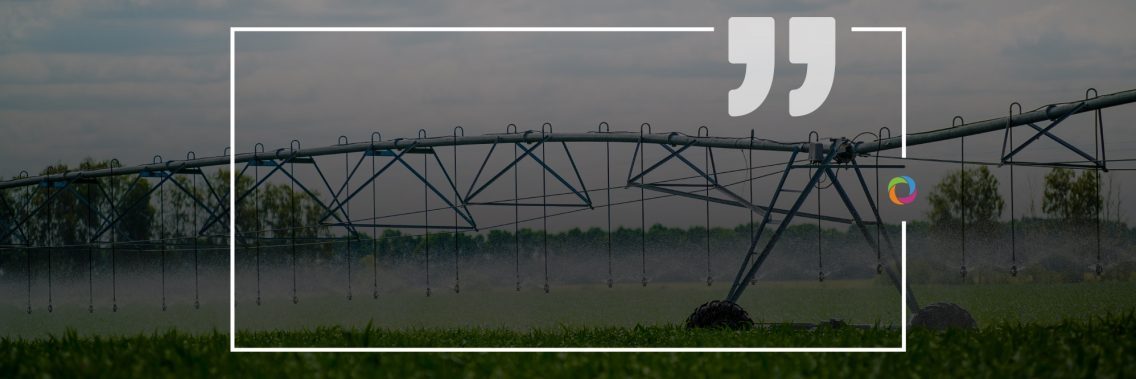According to the United Nations, water scarcity already affects every continent. Water shortages have drawn the attention of the development community to the necessity of achieving more efficient use of limited water resources, especially in agriculture to increase crop production and to achieve global food security in a sustainable way. This target, however, demands an increase in the irrigated area regardless of the water resources available. We asked several irrigation experts to share their opinions regarding the challenges, pros, and cons of implementing irrigation systems in developing countries. See how they responded below.
What are the challenges of implementing irrigation systems in developing countries?

“The first question of any irrigation system or project is always: where does the water come from? The water source is of the utmost importance. The source of water is the first hurdle to implementing a feasible, sustainable irrigation project. The source of water further relates to the quality of water, the quantity available, how far/near is it from the site, and how sustainable this water source is. These factors influence the project’s sustainability with direct cost implications. In some regions, you are lucky where the water is of suitable quality and the shallow water table allows for relative shallow boreholes to supply the water. For some other projects, the water source can be at a river several kilometers away, increasing the cost of the system. The project might still be feasible even with higher costs depending on the project’s return on investment. Infrastructure such as harbors, roads or railways is important for the shipping/logistics of the materials to the project site and is also of importance to link the project to markets. Access to markets is important too for the sustainability of the project after installation. A lack of decent roads slows down the movement of material to the project site. In sub-Saharan Africa, there are usually dirt roads that will form part or most of the route. During the rainy season, it can be almost impossible to use some of these to transport irrigation material and equipment to the site. In tropical countries with heavy rainfall, machinery gets stuck in mud and the ditches dug for the laying of pipes become water canals. The timing of the installation should be well planned according to the seasons to avoid the rainy season in tropical countries or heavy snow in cold regions. Also, the planting season must be considered. The irrigation installation should be installed during the months when it’s possible to work and transport material and for it to be completed before the planting season. This window of opportunity will differ between regions and crops and for some large projects, it won’t be long enough to implement the project in one year. In such cases, irrigation projects can be implemented in phases over several seasons. Local expertise and knowledge of the country or region of the country where the project is are important not only for the seasons and the knowledge of the site conditions but also for the implementation. A reliable trustworthy local partner in the country of operation can have a huge bearing on the success or failure of a project and not only at the implementation stage. At the time of issuing a tender, local knowledge of the area and the site conditions along with accurate costs, local staff and equipment can cause a tender to be accurate or not.”

“There are a number of challenges that prevent a broader scale-up of efficient irrigation solutions e.g., drip irrigation or micro-sprinklers, in emerging markets, particularly among smallholder farmers. To begin with, the cost of irrigation technology is often outside of what smallholder farmers can afford as an out-of-pocket expense. The more sophisticated the technology is, the more expensive it is for the farmer to acquire and install, especially, if the irrigation solution involves solar power. Government funds that could be used for subsidies are often routed to larger-scale public schemes, while commercial banks perceive smallholders to be a risky segment for lending. On top of that, the equipment is not always readily available on the market as agri-distributors may not have enough capital to maintain sufficient stock in the country. Additionally, developing countries often see significant market gaps. For instance, post-sale support such as irrigation maintenance services are not always readily available. To crown all this, water sources e.g., publicly provided bulk water supply surface water or a borehole are not always easily available. Moreover, in the case of surface water, water governance becomes critical as it involves multiple users and requires balancing water extraction.”

“One of the most important challenges in implementing irrigation system in developing countries is that the lack of adequate water resources to strengthen the agricultural production systems in these countries. It should be noted that 80% of water resources in the MENA region for example comes from outside the region as a transboundary water resources which indicates the high competition on water resources to support the different sectors include the agricultural one keeping in mind that 65% to 75% of the water resources in these countries goes to irrigation the agricultural land, therefore the growth of other sectors will be limiting the expansion in irrigation practices. Moreover the financial situation and the Return on Investment (ROI) in the agricultural sector in the developing countries is still low compared to that for developed countries which would also limit the ability of farmers in developing countries to adopt new innovative technology and monitoring instrumentation to assess the actual plant water requirement and consequently provide the adequate infrastructure to meet these water requirements based on actual plant water use within a given microclimatic conditions.”

“Irrigation development faces particular challenges in Africa, including widespread soil fertility issues, challenging political stability and institutional support in many countries, and similar climate change issues to those of Asia. The new paradigms for agriculture should be improved water use efficiency and diversification rather than increased water use. Countries such as Sudan could easily double the water use efficiency of rainfed sorghum and maize with improved dryland agronomy, including reduced tillage, the use of balanced fertilizer programs, and part mechanization. Highly sophisticated systems as seen in western countries are not yet required to improve output. Large scale irrigation is not the answer.”
What are some of the pros and cons of irrigation systems?

“Pros. Irrigation is a tool farmers use to increase yields and ensure constant yields season after season. With the increasing population of the world, more food needs to be grown on less land. Irrigation is an important tool to do this. There are a variety of types of irrigation systems suitable for different crops, soils, and crop growing conditions, from large centre pivots to grow stable foods and grains to the masses at affordable prices to the non-leak pressure compensating drip irrigation systems in hydroponic systems where water is continuously recirculated. Irrigation allows for crops to be grown in areas where rainfed agriculture is impossible because of insufficient or irregular rain. Irrigation is a tool in climate-smart agriculture and a mitigation of the effects of climate change. Through irrigation, farmers manage the risk of variable yields and ensure a constant income. Even in areas of rainfed agriculture, supplemental irrigation can be applied to increase yields. Cons. To enjoy the full benefit of irrigation, an irrigation system should be well planned (good irrigation design), well managed (good irrigation scheduling: when to irrigate and how much water to apply), and maintained (maintenance is crucial). An irrigation system with a good design, with proper irrigation scheduling, and sufficient maintenance is an important useful tool in the fight against hunger, to achieve an increase in farm incomes and to mitigate against climate change. An irrigation system that is badly designed or badly managed or where the maintenance is not done properly is a waste of financial resources, natural resources and is bad for the environment.”

“Different irrigation solutions have different sets of advantages and disadvantages. Typically, irrigation solutions are costly investments that are not always accessible to smallholders. The extensive use of irrigation, especially within large-scale, not very efficient systems, leads to the over-extraction of water thus aggravating water stress. The wrong choice of irrigation equipment may create agronomic issues (e.g., the use of sprinklers on some crops may lead to increased rates of pests and diseases). Some of the advantages of irrigation use are fairly obvious. Foremost, irrigation use improves yields. This is especially relevant in the context of climate change that makes producers increasingly vulnerable to changing weather patterns and extreme events e.g., droughts. Improvements in yields of food crops have the potential to boost food security. Irrigation also allows production during the dry season, and thus helps secure premium prices at the market and allows imports to be substituted with local produce. Some irrigation systems increase the overall efficiency of farm operations e.g., drip irrigation allows fertigation that brings water savings and ensures the targeted, economical use of fertilizer. There are also more nuanced advantages of having irrigation in place. For instance, when it is introduced in a gender-smart way, irrigation yields positive impacts for women farmers that are not just translated in improved yields and respectively incomes. On-farm irrigation solutions allow women to save the time they would otherwise spend fetching water from a well to their fields and allow them to invest this time in other activities. Moreover, such trips to the well mean security risks in fragile and conflict areas – a challenge that is particularly acute for women. Thus, on-farm irrigation solutions also have the potential to improve personal safety.”

“Developing countries are still lacking the use of High-Tech irrigation systems due to the financial constraints, however many of these countries like Egypt, Jordan and many others have started to manufacturer drip irrigation systems and accessories. This technology proved to save much of the water resources and reduce evaporated or infiltrated water resources. The demand on these technologies coupled with the low investment cost to procure them empowered farmers to shift from surface irrigation to drip irrigation; however such irrigation technology is subjected to using good-quality irrigation water. Some of these developing countries have witnessed secondary salinization therefor drip irrigation might not be a sustainable solution as a sole irrigation system to ensure washing out the salts from the soil rhizosphere in order to secure productive lands for generation to come.”

“Since the 1960s, when green revolution technologies combined with irrigation led to widespread Asian food security, irrigation development and prosperity have been seen as synonymous. That era ended in the early 2000s. There were several reasons: the costs of new large scale irrigation developed to adequate standards with laser guided levelling often exceeded $10,000 per hectare with the result that large investments benefited relatively few farmers; the technologies of the green revolution also included seed and fertilizer improvements but agricultural research and extension investment slackened in the 1980s. Problems such as salinity, acid sulfate soils and micronutrient deficiencies were not adequately addressed even in existing irrigation schemes until well into the new century; the reform of operation and maintenance arrangements so that farmers owned and managed the lower levels of the distribution system whilst the public sector controlled larger infrastructure commenced in the 1980s but were ongoing more than 20 years later, particularly in China; irrigation did not necessarily mean prosperity. Five of the poorest provinces in Cambodia were based on irrigated rice production. The upland irrigated areas of Lao PDR were developed on soils poorly suited to stable canal systems resulting in high maintenance costs; Climate change has reduced the availability of water in areas such as Eastern Indonesia. As a result, investments in farmer training, meteorological modelling, and better agronomy of a wider range of crops became more attractive investments.”
Check out more than 150 job opportunities in the Agricultural sector here.

